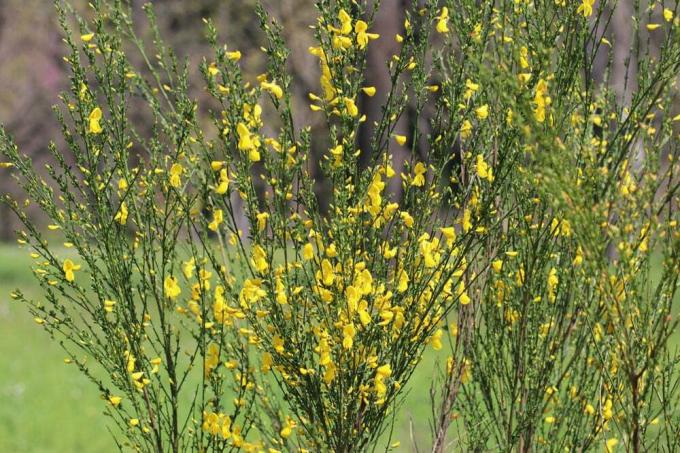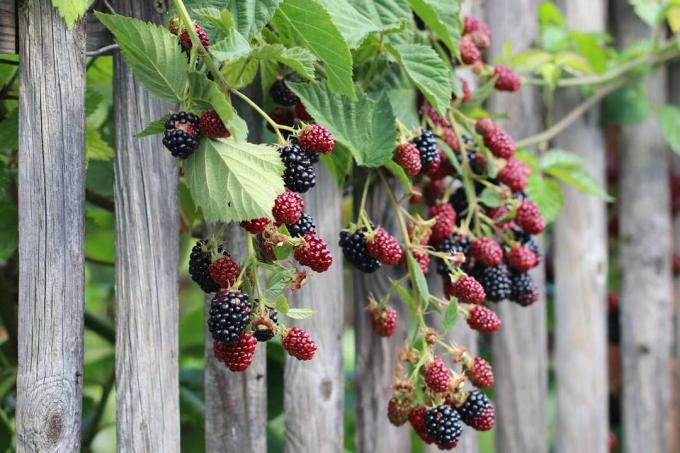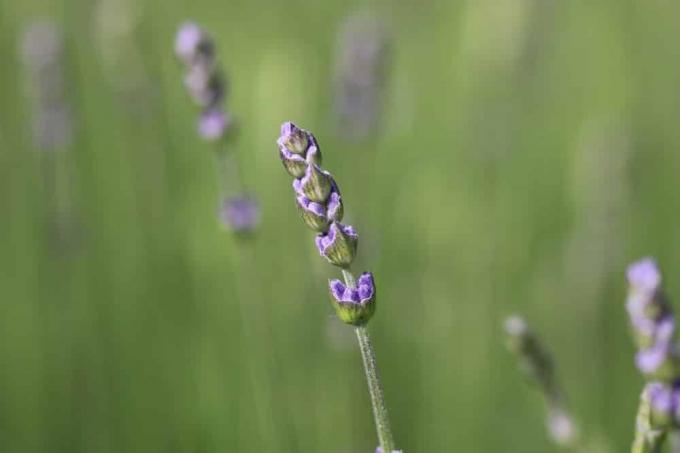

Table of contents
- When is the best time?
- Which tool is recommended?
- Shape cutting instructions
- Cutting the gorse hedge – you should pay attention to this
- Get old gorse going - instructions for the rejuvenation cut
- Raise and cut gorse to a standard - this is how you do it right
- base
- education phase
- Shape and maintenance cut
The most beautiful species and varieties of the gorse genus thrive as deciduous shrubs or subshrubs. Characteristic is rapid growth, which can take on invasive dimensions in the garden. At the same time, the ornamental trees tend to bare from below when the sun can no longer penetrate the dense heart of the plant. By trimming back your spring and summer gorse every year, you can keep volume and the urge to spread under control. In this context, continuity is very important because broom does not sprout from old wood or sprout only sparingly. If you don't prune the flowering shrub regularly, it will age from within and fall apart.
When is the best time?
The ideal time for pruning depends on the flowering period. The multi-faceted genus is not limited to its bright yellow spring bloomers. The native dyer's broom spoils us with a summer bloom that requires a different pruning date. For your orientation, we have summarized the most important time frames for you:
- Spring bloomers, such as ivory gorse or noble gorse: after flowering in June
- Summer bloomers, such as dyer's broom, winged broom or rose broom: in autumn
- Rejuvenation pruning on the old or bare bush: between 1. October and 28 February
- thinning: in late winter, preferably February
For the appointment itself, please choose a mild, dry day without blazing rays of sunshine. When it comes to deciding when you can rejuvenate an old broom bush, the legislature has a say. In the period from 1 March to 30. Birds nest in bushes and trees to raise their offspring here. Therefore, radical cuts are only allowed outside the breeding season. This applies equally to solitary shrubs, hedges and trees. Disturbing or even driving away nesting birds and small animals with offspring by pruning trees is punishable by fines of up to 50,000 euros.
Tip:
Beautify your garden or dry stone wall with the dainty cushion gorse (Cytisus decumbens) or the ground-covering creeping gorse (Cytisus beanii)? Then you can save yourself the trouble of an annual pruning. If the little beauties do overgrow in growth, cut back shoots that are too long at the end of the flowering period.
Which tool is recommended?

The be-all and end-all in skilfully pruning gorse is the right tool. In the first few years it is sufficient if you use sharp pruning shears. We recommend the bypass blade system because two sharp blades slide past each other. In contrast, the anvil blade system works on the basis of a single, sharp blade and a blunt metal base. This technique argues with reduced effort. A disadvantage is that bruises on the branches are to be feared. When pruning an old gorse, handle thicker branches with an ambidextrous bypass pruner. If you are confronted with 4 cm thick branches of a majestic noble gorse, a modern folding saw with pull-toothing leaves smooth cut surfaces that require no after-treatment.
Tip:
Careful disinfection of blades and saw blades is important for effective prevention of diseases and pests. Dirty cutting tools are the most common carriers of infections of all kinds. Therefore, clean your tool with spirit, alcohol or hot water before and after each cut.
Shape cutting instructions
Thanks to its easy care, good-natured pruning tolerance and bright flowers, broom is very popular as the ideal plant for beginners. With a combination of a sunny location, poor soil and annual topiary, you can get the best out of this ornamental shrub. The first two criteria require the right choice of location in the garden. The following instructions for the shape and maintenance cut sum up how you can easily meet the third criterion:
- Cut back faded shoots by a third or half
- Only cut in the leafy area
- Prune out fallen and fallen branches
- In addition, from the third year, cut off the two oldest shoots at the base
A fundamental pruning rule states that broom reacts to a strong pruning with an equally strong budding. Conversely, a slight topiary results in restrained growth. So that a young broom grows bushy, voluminous and full of flowers, the pruning can be extended to a growth height of 40 cm, as long as there are still leaves there. If you aim to curb its urge to spread in later years, limit the topiary to a third of the length of the shoot.
Tip:
Various noble brooms are susceptible to frost damage. These reveal themselves in the form of brown, dried shoot tips. If you cut an affected gorse back into the healthy wood in the spring, the mishap will not have a negative effect on the blossoms.
Cutting the gorse hedge – you should pay attention to this

As a solitary broom without its flowers, it loses a great deal of its decorative appeal. If you still don't want to miss out on the picturesque blossom festival, you can arrange the ornamental shrub as a hedge. In this case, you benefit from the aesthetics of the group, which makes it possible to get over the lack of flowers in autumn and winter. Regular pruning plays a key role in the care program when several broom bushes are in close proximity. Since the dense trees shade each other, they are more often affected by bare growth than when they are alone. So please grab a pair of scissors twice a year. That is how it goes:
- Cut the gorse hedge into shape after the flowering period
- Cut back branches that are too long and outgrowing
- Cut off shoots that are inclined or have drooped at the base
- Thin out the bushes in January/February and remove all dead wood
A light-flooded habit is important for a flowering and compact gorse hedge. After you have thinned out the hedge in late winter, the sun should be able to penetrate to the inside of each individual plant. It has therefore proven useful in practice to remove the two oldest shoots on the ground every winter on adult or senescent broom bushes, even if they are not deadwood.
Get old gorse going - instructions for the rejuvenation cut
If you have neglected to cut back over a period of 3 to 4 years, the leaves and flowers will shift towards the tips of the shoots. Ultimately, the loose ornamental shrub falls apart and bare from the base. With a rejuvenation pruning, you breathe fresh life into the lazy, old broom. How to proceed correctly:
- Cut back all branches radically in autumn or late winter
- Start the scissors before the last branch above the ground
- Cut or saw off dead branches at the base
- Smooth out larger cuts on the old wood with a knife
Only a few types of broom tolerate a cut in the senile wood. Therefore, when cutting, please ensure that at least two to three dormant eyes or leaves remain on the shoot. If you cannot see any vegetation points, run your finger over the bark. Leaf knots can often be felt as slight elevations.
A notice:
All types and varieties of the broom genus are poisonous. Therefore, please wear gloves when caring for and cutting the shrub.
Raise and cut gorse to a standard - this is how you do it right
The loosely upright or elegantly overhanging growth makes gorse a popular standard for creative garden design. Ready-to-bred high stems from the specialist trade have a steep price because the upbringing is time-consuming. Only through continuous pruning measures does a gorse get the ideal shape with a bushy crown and slender trunk. Otherwise, natural growth will prevail as a shrub with numerous shoots on the ground. For the ambitious home gardener, it is a matter of honor to raise the flowering shrub to a standard on their own. The following instructions explain step by step how to do it:
base
To start with cutting up a high stem, you need a strong young plant that has a stable central shoot. You can either grow the plant from a cutting of your loveliest broom in the garden or buy a container plant from your trusted tree nursery. Bare-root trees are suboptimal as a starting point. If you want a spherical crown shape, upright broom species such as dyer's broom (Genista tinctoria) can be considered. Favor a crown with casually hanging branches, focus on ivory broom (Cytisus praecox) or noble broom (Cytisus scoparius). You will also need a support rod, sharp scissors and soft tubular tape or special tree ties from a specialist shop.
education phase

It depends on the type of gorse you choose, how long the training phase lasts. With an average growth rate of up to 50 cm per year, a small standard has reached its ideal height within 2 to 3 years. It takes several years to achieve a height of 150 to 200 cm with a noble broom. How to proceed professionally:
- Tie the center drive to the support rod
- Cut off competing vertical shoots and side shoots
- Continue untying the new shoots at the top of the trunk from year to year
- Cut off side branches regularly to encourage growth of the center shoot
Only when the trunk has reached the perfect height, cut off the top. Set the scissors at a distance of three to four leaves above the base of the crown. Please keep in mind that with this cut you determine the final trunk height. Subsequent corrections are rarely successful. At the same time as you cut the top of the trunk, start branching to the crown. After each flowering period, prune back the side branches to 3 to 4 buds until it has reached the desired volume. Do not remove the support rod at this stage. Only when you are sure that the trunk can support the crown on its own will the support have done its job.
Shape and maintenance cut
An annual pruning ensures that your gorse keeps its shapely crown as a standard. When you do the pruning again depends on the end of each flowering season. You should cut back all side shoots that protrude from the crown by autumn at the latest. Throughout the year, consistently remove branches from the trunk that sprout below the crown. Ideally, you should cut off steep, upward competing shoots to the trunk in a timely manner, because they claim nutrients and water for themselves. In connection with the topiary or in late winter, thin out the crown thoroughly.
 Home editorial office
Home editorial office
Learn more about pruning

Eucalyptus dried up: cut back now?
When a eucalyptus dries up, some owners immediately think of cutting it back. Because they want to see fresh green bud quickly. The chances of that happening may be good. But one thing must not be left out: research into the causes! Otherwise a new cycle of drying up and cutting begins.

Cut blackberries: Instructions for the right cut
Bramble branches only bear fruit for one summer, after which they are used up and die off in winter. It's a good thing that new canes grow back in time for the following year. Cutting care means: What no longer supports should be removed, young rods must be optimally trained.

cutting snowball | 13 tips for pruning
When it comes to snowballs (Viburnum), the opinions of numerous hobby gardeners differ when it comes to cutting. Main reason against pruning: Destruction of the natural appearance by pruning. Find out now when it is unavoidable and which tips should be heeded.

Cutting sage: 6 tips for cutting back
Cutting measures and their ideal time depend on the species of sage plants, because they have differentiated ways of life. There are woody and herbaceous representatives that require different attention. In order to carry out the measures, a basic set of tools is helpful.

Pruning hydrangeas: when is the right time?
Hydrangeas are a real beauty because of their flowers. In the long term, however, the flowering power is only maintained if regular pruning takes place. Because cutting off withered or dried plant parts offers protection. The following guide shows when this measure should be taken.

Cutting Lavender | When is the best time?
Lavender is a popular perennial, but difficult to cut. Without regular pruning, the shrub becomes lignified and less robust. Choosing the right time is important for pruning. When to cut depends on the use of the perennials.



